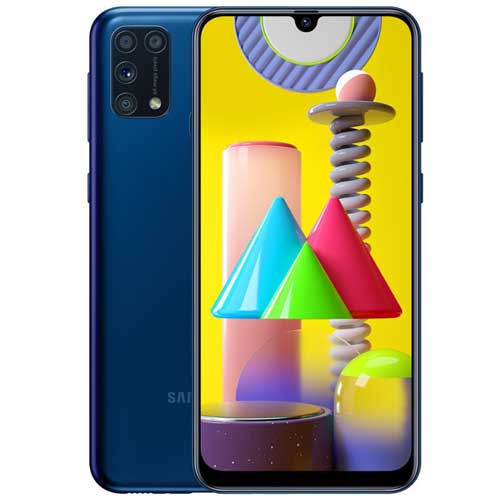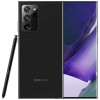Samsung has expanded its budget segment with the latest M-series smartphones. The company has launched the Galaxy M31 domestically, starting at a very affordable price.This smartphone has a competent processor, large battery and installation for four cameras. The company offers good packaging for this price, so it will compete fiercely with the rest of the products. We've had the opportunity to use our Samsung Galaxy M31 for a while, and here's a full review.
Highlights-
* The Samsung Galaxy M31 sports the same Exynos 9611 SoC as the Galaxy M30s
* It packs a quad-camera setup at the back
* The Galaxy M31 offers very good battery life
Samsung Galaxy M31 Design-
At first glance, it is difficult to distinguish the Samsung Galaxy M30s from the Galaxy M31 on the front. Both smartphones have a large 6.4-inch display with a water slot, which Samsung calls the Infiniti U display. The frame is not thin, but cheap. Like other M-series smartphones, Samsung uses plastic to make the Galaxy M31. The headset is elegant and sits just above the display of the smartphone bezel. Grab the Galaxy M31 and feel comfortable in your hand. The sides are slightly curved to make it easier for you to grip it. Samsung has placed the power button and volume rocker on the right side of the device. The power button is easily accessible, but the volume button could be in a more comfortable position. On the left is a SIM card, which is completely invisible in the test.
The Galaxy M31 has a 3.5mm headphone jack, main microphone, USB Type-C port, and a bottom speaker. Above only the auxiliary microphone. When you look at the back of the Galaxy M31, you'll see some changes. The camera module is similar to that of the Galaxy M30s but it now packs a fourth camera. Next to this is the fingerprint scanner which was comfortable for us to reach while holding the smartphone.
The company offers the Galaxy M31 in two colors: Ocean Blue and Space Black. There's a Space Black version worth considering, and fingerprints and smudges are very easy to remove. There is no case in the box, so you can buy one as your choice.
Display-
The Samsung Galaxy M31 features a 6.4-inch Full HD AMOLED display with 2340 x 1080 pixels. The screen is protected by a three-layer Corning Gorilla Glass. The screen provides a wide viewing angle, and the large screen allows you to enjoy movies and games. The display is equipped with a conventional blue light filter that limits the amount of blue light and reduces eye strain.
There is also a dark mode that turns the entire phone into a dark color. You can turn on dark mode manually or automatically by opening the settings menu. There is also a Collision Avoidance option that can help prevent accidental screen touching. The device is also available as a permanent display showing time, date and pending notifications. It's an inexpensive smartphone, but it looks nice.
Software-
Like all other Galaxy phones released by Samsung in 2020, the Galaxy M31 instantly launches Android 10 with One UI 2.0. It runs on UI Core 2.0, an outdated version of One UI 2.0 that Samsung added to the Galaxy M20 and Galaxy M30 through the Android 10 update. It lacks basic features like a built-in screen recorder or secure folder. Samsung Pay and Samsung Pay Mini are also not supported. Bixby is also completely absent, except for Bixby Vision in the camera app. And when I discovered Samsung, why does the M-series run at the core of the user interface?
I've heard that the company is developing all phones when devices like the M30 and M31 used the same processor as the Galaxy A51, which received the One UI 2.0 standard (although not all features),According to the target market.However, that doesn't explain why things like Samsung Pay Mini and Secure Folder aren't part of the package, and you might assume Samsung wants to keep some of its exclusive features at the same price.
Since the Galaxy M31 runs Android 10 out of the box, it will receive an update to Android 11 and Android 12 at some point. Android 11 might arrive quickly – the Galaxy M20 and M30 received the Android 10 update before the Galaxy Note 10 did, after all. Security updates are likely to come once every three months for the first two years, and whenever necessary from the third year onward.
Performance-
The Samsung Galaxy M31 is powered by an Octa 10nm processor based on the Samsung Exynos 911, the company has not updated the smartphone like its predecessor in terms of processor. Galaxy M30s also run on the same chipset. The smartphone has 6GB of RAM and two storage options - 64GB and 128GB. Users can expand the storage up to 512GB by adding a microSD card. Compared to the Galaxy M30, the Samsung Galaxy M31 has more RAM, so multitasking is smooth. There were no delays or contacts with the phone.
The device runs smoothly and quickly when switching apps and playing games every day. The fingerprint sensor on the back works quickly even when the device is unlocked. The Samsung Galaxy M31 runs Android 10, which is protected by the company's One UI 2.0 level. The user interface is very clean and the large app icons make your device look great. There are also application boxes that we use.
There is also an app drawer where users can hide all apps and easily manage their home screen. Like other Samsung smartphones, this smartphone comes with all the standard Samsung apps preinstalled, as well as some third-party apps like Facebook, Amazon, Snapchat, etc. Samsung did not include Bixby in the Galaxy M31 and the device did not have the Bixby Vision app. In addition, this device has digital wellness and parental control options that provide a variety of standard gestures. For example, users can wake up the device from sleep mode with a double tap, and users can also hide the three-button navigation scheme and control their smartphone with full-screen gestures.
Camera performance-
The Galaxy M31 has 4 rear cameras and a 32MP selfie camera. The main camera of the Galaxy M31 has a resolution of 64 megapixels and an aperture of 1: 1.8. By default, the camera captures images at 16 megapixels, but you can switch to full resolution. It also features an 8MP ultra-wide-angle camera with a 123-degree field of view and f / 2.2 aperture. The other two are a 5MP depth sensor and a 5MP macro camera. Samsung's camera app was the same as before and was very easy to find.
There is a button to switch between the main and wide-angle cameras. Scene Optimizer quickly recognizes the scene and adjusts the camera accordingly. The Galaxy M31 has a square camera on the back. We quickly figured out what the Galaxy M31 was shooting and locked focus throughout the day. The pictures are good, with good detail. Text that is far away can be read by zooming in. Smartphone automatically activates HDR if required.
Switching to the wide-angle-camera is easy and you can get a wider field of view. However, while these shots look great as is, zooming in reveals that this sensor misses out on details. Wide-angle shots also have barrel distortion at the edges.
The Galaxy M31 can separate subjects and backgrounds when shooting close-ups, creating a natural sense of depth. However, it seemed to us that bright colors are reproduced so aggressively that details are lost. The camera takes good pictures outdoors, but indoors the picture quality is poor. Output is limited to 5 megapixels. Portraits are great, and the camera app lets you adjust the blur before shooting. It has excellent edge detection, and the Galaxy M31 separates the subject well from the background.
The Galaxy M31 stays in focus longer in low light conditions. So, you need to be patient when shooting. Low light photos are just as good as before, but if you zoom in, you'll see fine particles in the output. Switching to night mode reduces the ingress of particles into the outlet. Selfies taken with the Galaxy M31 are fine if taken in sufficient light, but they are poor quality and give grainy results in low light.
Video Performance-
Video recording maxes out at 4K for the primary rear camera and the selfie shooter. The Galaxy M31 meters light properly when shooting during the day, however, we found that the footage wasn't well stabilised. There is a Super Steady mode that uses the wide-angle-camera and crops the frame to minimise shakes. We got well-stabilised output using this mode, but the video lacked detail. There's no stabilisation at 4K.
Battery life-
The Samsung Galaxy M31 has the Galaxy M30 and an unchanged 6000mAh large battery. We're happy to know that Samsung is not running out of battery because that sets the smartphone apart from most of its competitors in this segment. The Galaxy M31's battery life is impressive from everyday use to gaming and from media consumption to standby. Your phone can be abused for more than one day and less than half a day. This only includes social media search and messaging. In PCMark benchmark, the Galaxy M31 lasted an impressive 14 hours 40 minutes at 100-20%. The Galaxy M31 supports 15W fast charging, which is pretty frustrating considering the size of the battery. It took 3 hours to charge the phone from 0% to 100%.
Audio & Call Quality -
The M31 has one speaker that works when you are in a small room. Otherwise, the sound will be too low to be heard at maximum volume. It's the same for all budget Galaxy phones, and the M31 doesn't change that. Like the M30 speakers, the M31 does not flex at maximum volume. This can be done deeper at lower frequencies. For wired audio, you'll have to opt for a third-party product as the phone doesn't have headphones. Along with headphones from other Galaxy smartphones in the lower / middle price range, the M31 emits a very strong sound at high frequencies (high frequencies), but this does not affect low frequencies. As far as the call quality is concerned, there were no problems with the SIM card I used, except that the handset and speaker were quieter and I could not hear anyone on the other side of the phone.
Pros-
* Terrific battery life
* Attractive AMOLED display
* Smooth software experience
* Decent performance
* Good photo quality in daylight
Cons-
* Poor low-light camera performance
* Processor could be better
* Uninspiring design
* Spammy notifications
* Poor video stabilisation
Final Verdict-
Since Samsung was with the Galaxy M30, I don't want to fix anything that didn't break. The company has increased the amount of RAM installed on the fourth rear camera and preloaded Android 10. The Galaxy M31 isn't exactly a new device, but an update to the Galaxy M30. The Exynos 9611 is possible, but I wouldn't complain if I had a more powerful processor to beat the competition. The improvements make this phone a little better and more versatile, but not much improved. The focus is still on battery life, and you can easily use it for two days without being plugged in. Competing at this price level may not be easy. Redmi Note 8 Pro (tested) and Realme X2 (tested) in general still have even more success. However, if you're looking for a device that covers the basics and has a good battery, then the Galaxy M31 is a great fit.


 The Samsung Galaxy Note series has always been the smartphone of most professionals, myself included. I was originally connected and haven't been able to walk since then. With Note devices, you feel like you can do whatever matters. And that's the feeling I got again after holding the Samsung Galaxy Note 20 Ultra 5G in my hand. But worth Rs 1 Lakh+ money, is this phone worth it? Read the review for
The Samsung Galaxy Note series has always been the smartphone of most professionals, myself included. I was originally connected and haven't been able to walk since then. With Note devices, you feel like you can do whatever matters. And that's the feeling I got again after holding the Samsung Galaxy Note 20 Ultra 5G in my hand. But worth Rs 1 Lakh+ money, is this phone worth it? Read the review for Vivo has recently launched a mid-range segment in August 2020. And It's a Y-series(20) smartphone. Before this Y20,Vivo has already launched a lot of Y series phone at a very affordable price such as Y50, Y11, Y90 etc. This time we are going to see what new or special features Vivo has added. With Vivo Y20, Vivo also has launched another model of Y series that is named Y20i. This two phones
Vivo has recently launched a mid-range segment in August 2020. And It's a Y-series(20) smartphone. Before this Y20,Vivo has already launched a lot of Y series phone at a very affordable price such as Y50, Y11, Y90 etc. This time we are going to see what new or special features Vivo has added. With Vivo Y20, Vivo also has launched another model of Y series that is named Y20i. This two phones Tecno's popular series of smartphones 'Tecno Spark 6 Air' has been launched in Bangladesh which is a low budget phone. Officially, the sale of the phone has already started in the market. The last few days I have been using this phone. And I have found the similarity of the Tecno Pouvier 4 with the phone in use. The key is to buy the phone that will attract the buyers. But the
Tecno's popular series of smartphones 'Tecno Spark 6 Air' has been launched in Bangladesh which is a low budget phone. Officially, the sale of the phone has already started in the market. The last few days I have been using this phone. And I have found the similarity of the Tecno Pouvier 4 with the phone in use. The key is to buy the phone that will attract the buyers. But the Technological advances are making cell phones smarter every day. But the price went up too! If you want to buy a smartphone at an affordable price with modern features, don't miss to check out the realme 7 series! Recently, Realme has launched a new smartphone in its Realme 7 series - the Realme 7i. The new budget Realme smartphone joins the Realme 7 and the Realme 7 Pro devices that were launched
Technological advances are making cell phones smarter every day. But the price went up too! If you want to buy a smartphone at an affordable price with modern features, don't miss to check out the realme 7 series! Recently, Realme has launched a new smartphone in its Realme 7 series - the Realme 7i. The new budget Realme smartphone joins the Realme 7 and the Realme 7 Pro devices that were launched Technological advances are making cell phones smarter every day. But the price went up too! If you want to buy a smartphone at an affordable price with modern features, don't miss the Realme C series! Having opened in the local market in Bangladesh in February 2020 with the launch of realme C2, the pioneering realme brand surprised us with a wide range of high-end phones at a reasonable price range. In this
Technological advances are making cell phones smarter every day. But the price went up too! If you want to buy a smartphone at an affordable price with modern features, don't miss the Realme C series! Having opened in the local market in Bangladesh in February 2020 with the launch of realme C2, the pioneering realme brand surprised us with a wide range of high-end phones at a reasonable price range. In this